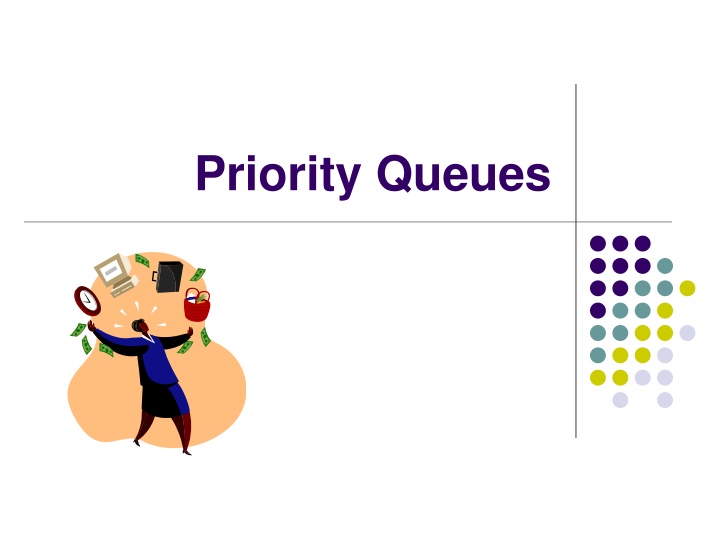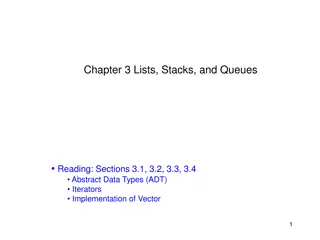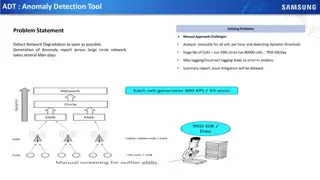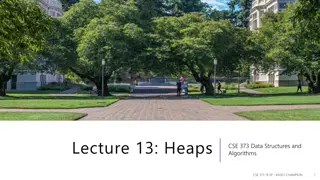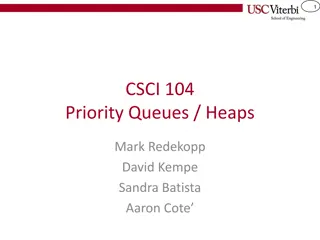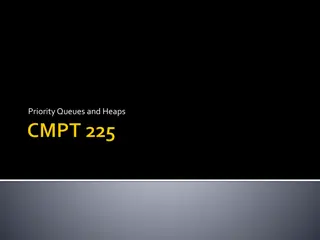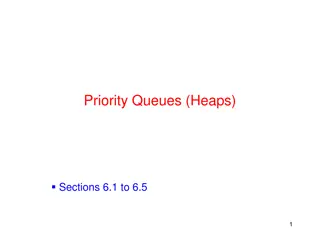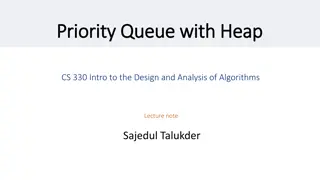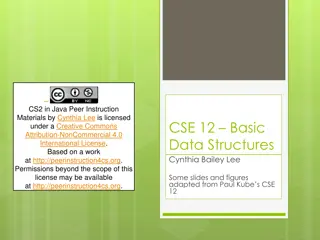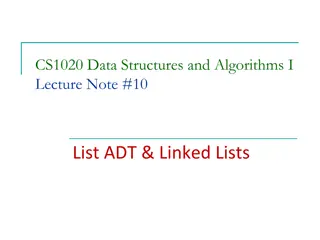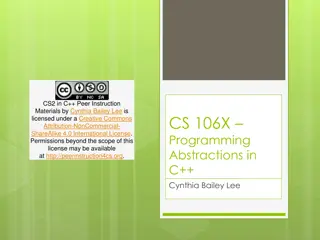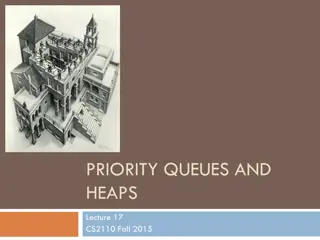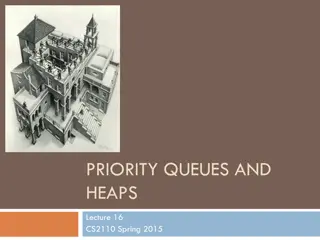Priority Queues and Comparator ADT
Priority Queues are data structures that store entries in order based on priority levels. The Priority Queue ADT allows for efficient insertion and removal of entries with key-value pairs. Entries in the queue are compared using a Comparator ADT, which encapsulates the action of comparing objects based on a total order relation. Sorting with a Priority Queue involves ordering elements by priority level, with operations like offer, poll, and peek. Java's PriorityQueue class orders elements by natural ordering. The Collection interface and Collections class in Java provide the foundation for managing collections of objects.
Uploaded on Mar 19, 2025 | 1 Views
Download Presentation

Please find below an Image/Link to download the presentation.
The content on the website is provided AS IS for your information and personal use only. It may not be sold, licensed, or shared on other websites without obtaining consent from the author.If you encounter any issues during the download, it is possible that the publisher has removed the file from their server.
You are allowed to download the files provided on this website for personal or commercial use, subject to the condition that they are used lawfully. All files are the property of their respective owners.
The content on the website is provided AS IS for your information and personal use only. It may not be sold, licensed, or shared on other websites without obtaining consent from the author.
E N D
Presentation Transcript
Priority Queue ADT A priority queue stores a collection of entries Each entry is a pair (key, value) Main methods of the Priority Queue ADT insert(k, x) inserts an entry with key k and value x removeMin() removes and returns the entry with smallest key Additional methods min(): returns, but does not remove, an entry with smallest key size(), isEmpty()
Entry and Key An entry in a priority queue is simply a key-value pair Priority queues store entries to allow for efficient insertion and removal based on keys A key is An object used to identify the priority of an entry of a priority queue
Comparator ADT A comparator encapsulates the action of comparing two objects according to a given total order relation When the priority queue needs to compare two keys, It can uses a user-supplied comparator The primary method of the Comparator ADT: compare(a, b): Returns an integer i such that i < 0 if a < b, i = 0 if a = b, i > 0 if a > b;
Sorting with a Priority Queue AlgorithmPriorityQueueSort(sequence S, priority Q P) while (!S.isEmpty( )) do e=S.removeFirst( ); P.insert(e); while (!P.isEmpty( )) do e=P.remove( ); S.insertLast(e); Refer to TreeMapSorting Project
Javas PriorityQueue Class PriorityQueue orders elements by their natural ordering. inserts elements in priority order such that the highest-priority element (i.e., the largest value) will be the first element removed from the PriorityQueue. Common PriorityQueue operations are offer to insert an element at the appropriate location based on priority order poll to remove the highest-priority element of the priority queue peek to get a reference to the highest-priority element of the priority queue Refer to PriorityQueueSorting Project
Collection Interface and Collections Class
Collection interface and Collections class Interface Collection is the root interface from which interfaces Set, Queue and List are derived. Interface Set defines a collection that does not contain duplicates. Interface Queue defines a collection that represents a waiting line. Class Collections provides static methods that search, sort and perform other operations on collections.
Lists and LinkedList class A List (sometimes called a sequence) is a Collection that can contain duplicate elements. is implemented by several classes, including ArrayList, and LinkedList. A LinkedList enables efficient insertion (or removal) of elements in the middle of a collection.
LinkedList methods addAll appends all elements of a collecton to the end of a List. listIterator gets A List s bidirectional iterator. subList obtains a portion of a List. This is a so-called range-view method, which enables the program to view a portion of the list. Refer to LinkedListApp Project
Arrays as Lists Class Arrays provides static method asList to view an array as a List collection. A List view allows you to manipulate the array as if it were a list. This is useful for adding the elements in an array to a collection and for sorting array elements. Refer to UsingToArray Project
Collections Methods Class Collections provides several high-performance algorithms for manipulating collection elements. Refer to UsingCollectionsMethod Project
Sets A Set is an unordered Collection of unique elements (i.e., no duplicate elements). The collections framework contains several Set implementations, including HashSet and TreeSet. HashSet stores its elements in a hash table, and TreeSet stores its elements in a tree.
Sets (Contd) TreeSet method headSet gets a subset of the TreeSet in which every element is less than the specified value. tailSet gets a subset in which each element is greater than or equal to the specified value. first and last get the smallest and largest elements of the set, respectively. Refer to RemovingDuplicates Project
